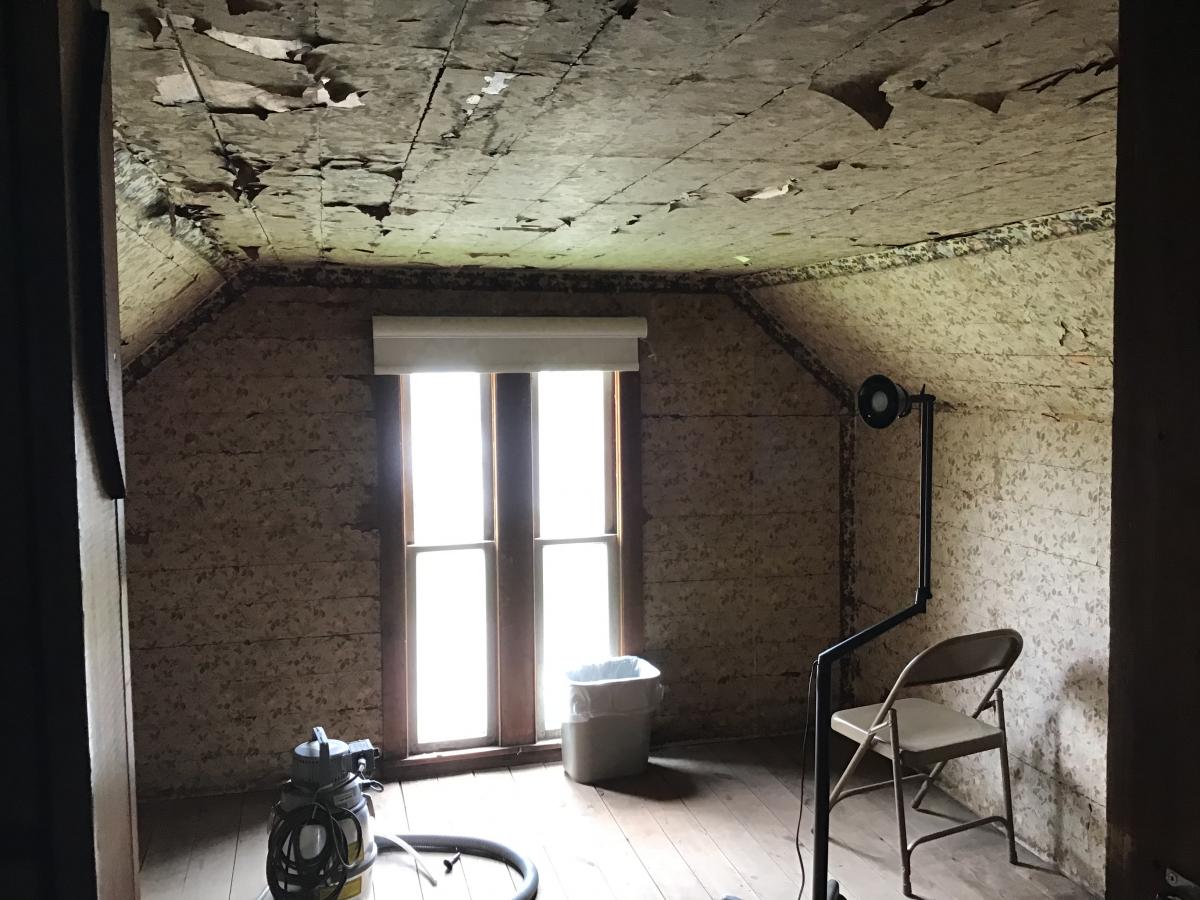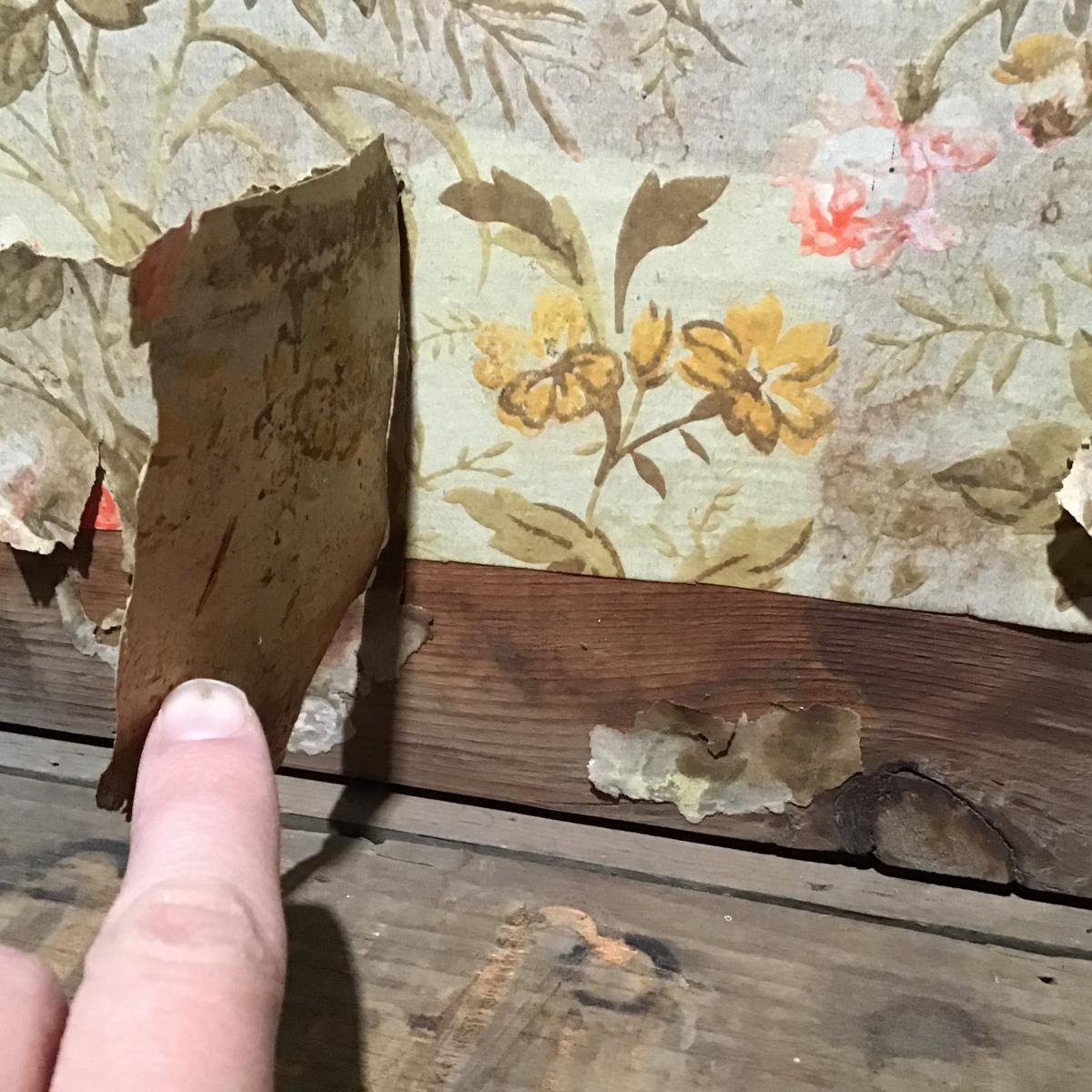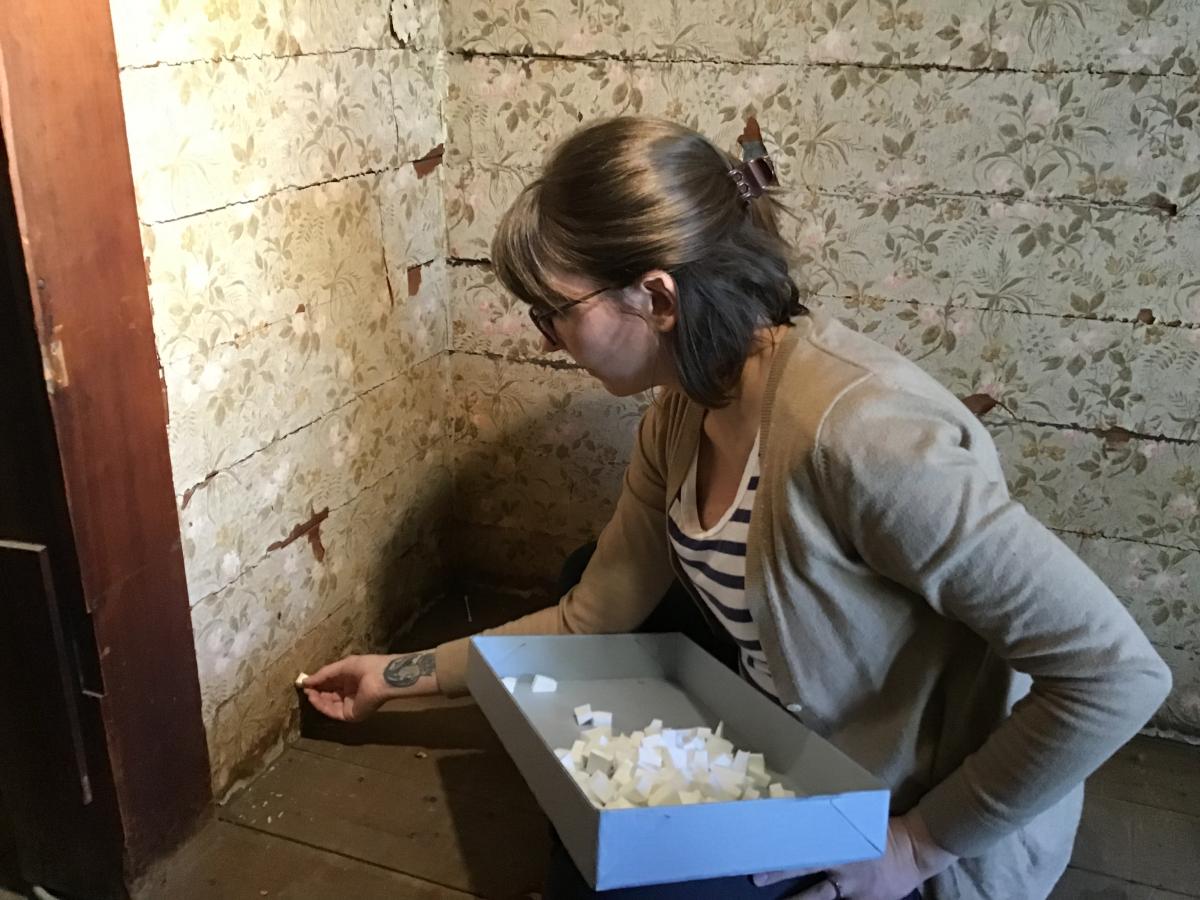(Posted June 19, 2019)
The original wallpaper in the attic of Willa Cather’s childhood home is an artifact with a rich historical and literary significance. Our conservators are helping the National Willa Cather Center preserve its material & historical context.
Learn more about their process.
The Cather Childhood Home is one of several historic properties that belong to the Willa Cather Foundation in Red Cloud, Nebraska. Willa Cather lived in this house in the 1880s and 1890s. Her attic bedroom is significant because it retains the original wallpaper Cather herself applied as a young girl, and later wrote about in works such as Song of the Lark.

Interior of the room with north-facing window. You can see the extent of the damage particularly on the ceiling.
The wallpaper has been in a very deteriorated state for several decades and continues to get worse. It was applied directly to the acidic wooden boards of the attic and roof, and there are have been no environmental controls in the room. The Willa Cather Foundation has been working with History Nebraska and Ford Conservation Center conservators to determine the safest and most appropriate course of action to best lessen further damage to the historic wallpaper.
The wallpaper was originally a pale green with bright pink roses, yellow wildflowers, and green and brown foliage. The wallpaper was adhered with a starch-based wallpaper paste and applied to the four walls and the ceiling. Another boarder wallpaper and small patches of a different wallpaper were applied around the room at an unknown later date.
Overall, the wallpaper in the Cather bedroom is in very poor condition. At first glance, many small and large pieces of wallpaper are missing from the walls. Partially detached sections are limply hanging or ready to fall off. There is a large area of water damage on the west wall and ceiling that has caused dark brown staining and paper loss. Upon close inspection, the wallpaper is jaggedly torn along nearly all of the board seams. The wallpaper has sustained considerable structural and surface damage as a result of the attic environment, including acidic products from the wood, fluctuations in temperature and relative humidity, and light damage.
There is a considerable amount of surface soiling on the wallpaper and in the attic bedroom. Soiling describes dirt, dust, skin cells, atmospheric pollutants, and any other particulate matter that settles on the surface of artifacts. Surface soiling can be lying on the surface, embedded within the paper fibers, or both, as with deposits like flyspecks. The soiling has occurred in large part because the room is not sealed from the outside environment. Debris and particulate matter have freely entered the room through the board seams, collecting behind and on the wallpaper, and filtering through into the entire space. There are significant accumulations of dirt behind the paper and in the cracks.
Aside from using a HEPA vacuum, canned air was used to remove dirt that had accumulated behind the wallpaper, especially where the ceiling met the wall.
Continual light exposure from the north window has contributed to the colors fading in the wallpaper. This can be seen in an area where the wallpaper overlapped another piece. The visual contrast between the exposed paper and the area that was protected from light damage is striking. Exposure to visible and ultraviolet radiation is a significant factor in the survival of objects. Unfortunately, the damage caused by photo-oxidation, or degradation from light exposure, does not just cause colors to fade. Paper becomes brittle, physically unstable, and is structurally altered. Damage caused by light exposure is cumulative and cannot be reversed.

In areas where the wallpaper overlaps, the vibrant original colors, undamaged by dirt and light exposure, can still be seen.
Previous on-site tests conducted in the Cather bedroom were successful at reducing surface soiling through dry cleaning methods. Overall, this testing showed that the wallpaper could not be safely removed from the wood substrate without significant loss of original wallpaper material.

Paper Conservator, Hilary LeFevere, uses Japanese tissue and various adhesives to test possible options for re-adhering loose sections back to the wall boards.
In April, Paper Conservator Hilary LeFevere, and technician Megan Griffiths went to Red Cloud to spend a week surface cleaning the wallpaper and conducting further tests. The goal of this round of treatment was to reduce loose soiling and dirt to the extent possible. The conservators used various dry cleaning methods including HEPA filtration vacuuming, cosmetic sponges and cotton swabs. Cleaning was done on exposed wallpaper surfaces, exposed board, and in board seams where dirt and debris had accumulated. In four-and-a-half days, the four walls were cleaned and the floor and ceiling extensively vacuumed. Hilary also tested some adhesives with Japanese tissue to see what might work best for future treatments to re-adhere the loose sections of paper.

Conservation Technician, Megan Griffiths, surface cleans the wallpaper with cosmetic sponges. Each of the walls were vacuumed, then cleaned with sponges and cotton swabs.
The original wallpaper in the attic of the Cather Childhood Home is a unique artifact rich with historical and literary significance. The environmental conditions and building construction have contributed greatly to the very poor condition and degraded state of the wallpaper. Without question, the wallpaper will continue to degrade. However, actions have begun to be taken to care for the wallpaper in place, and still provide a meaningful experience for visitors to the site. Future actions will include on-going preservation activities like routine housekeeping, in addition to reducing UV and visible light exposure, and providing a more stable environment through building modifications such as a new HVAC system that serves both floors of the house. Potential mitigation activities performed by conservators can help to slow the rate of loss of original material and retain the historical context of the Cather bedroom.



